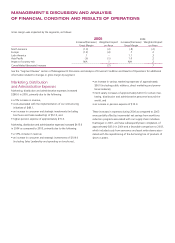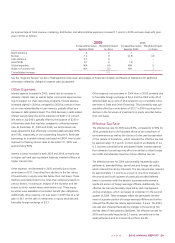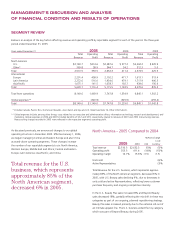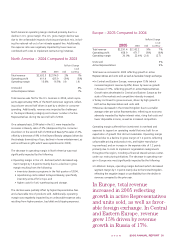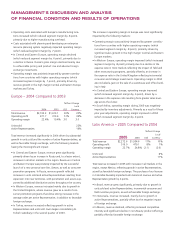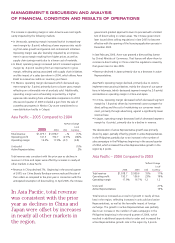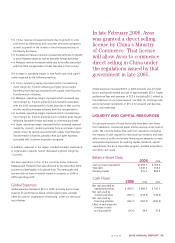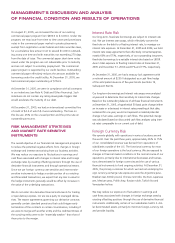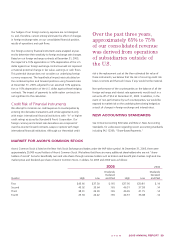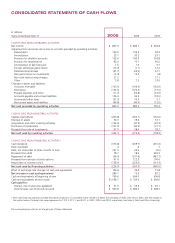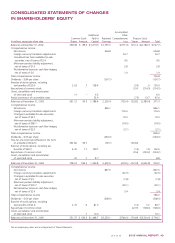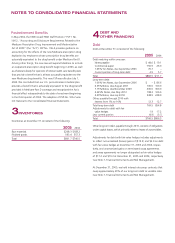Avon 2005 Annual Report Download - page 18
Download and view the complete annual report
Please find page 18 of the 2005 Avon annual report below. You can navigate through the pages in the report by either clicking on the pages listed below, or by using the keyword search tool below to find specific information within the annual report.MANAGEMENT’SDISCUSSIONANDANALYSIS
OFFINANCIALCONDITIONANDRESULTSOFOPERATIONS
On August 31, 2005, we increased the size of our existing
commercial paper program from $600.0 to $1,000.0. Under the
program, we may issue from time to time unsecured promissory
notes in the commercial paper market in private placements
exempt from registration under federal and state securities laws,
for a cumulative face amount not to exceed $1,000.0 outstand-
ing at any one time and with maturities not exceeding 270 days
from the date of issue. The commercial paper short-term notes
issued under the program are not redeemable prior to maturity
and are not subject to voluntary prepayment. The commercial
paper program is supported by our credit facilities. Outstanding
commercial paper effectively reduces the amount available for
borrowing under the credit facility. At December 31, 2005, we
had commercial paper outstanding of $756.9.
At December 31, 2005, we were in compliance with all covenants
in our indentures (see Note 4, Debt and Other Financing). Such
indentures do not contain any rating downgrade triggers that
would accelerate the maturity of our debt.
At December 31, 2005, we had an international committed line
of credit of $4.3 of which $.3 was outstanding. The fees on
this line are .25% on the unused portion and the prime rate on
outstanding amounts.
RISKMANAGEMENTSTRATEGIES
ANDMARKETRATESENSITIVE
INSTRUMENTS
The overall objective of our financial risk management program is
to reduce the potential negative effects from changes in foreign
exchange and interest rates arising from our business activities.
We may reduce our exposure to fluctuations in earnings and
cash flows associated with changes in interest rates and foreign
exchange rates by creating offsetting positions through the use of
derivative financial instruments and through operational means.
Since we use foreign currency rate-sensitive and interest rate-
sensitive instruments to hedge a certain portion of our existing
and forecasted transactions, we expect that any loss in value for
the hedge instruments generally would be offset by increases in
the value of the underlying transactions.
We do not enter into derivative financial instruments for trading
or speculative purposes, nor are we a party to leveraged deriva-
tives. The master agreements governing our derivative contracts
generally contain standard provisions that could trigger early
termination of the contracts in certain circumstances, including if
we were to merge with another entity and the creditworthiness of
the surviving entity were to be “materially weaker” than that of
Avon prior to the merger.
Interest Rate Risk
Our long-term, fixed-rate borrowings are subject to interest rate
risk. We use interest rate swaps, which effectively convert the
fixed rate on the debt to a floating interest rate, to manage our
interest rate exposure. At December 31, 2005 and 2004, we held
interest rate swap agreements that effectively converted approxi-
mately 60% and 75%, respectively, of our outstanding long-term,
fixed-rate borrowings to a variable interest rate based on LIBOR.
Avon’s total exposure to floating interest rates at December 31,
2005 and December 31, 2004 was 81% and 77%, respectively.
At December 31, 2005, we had a treasury lock agreement with
a notional amount of $250.0 designated as a cash flow hedge
of the anticipated issuance of five-year bonds (see Note 19,
Subsequent Events).
Our long-term borrowings and interest rate swaps were analyzed
at year-end to determine their sensitivity to interest rate changes.
Based on the outstanding balance of all these financial instruments
at December 31, 2005, a hypothetical 50 basis point change (either
an increase or a decrease) in interest rates prevailing at that date,
sustained for one year, would not represent a material potential
change in fair value, earnings or cash flows. This potential change
was calculated based on discounted cash flow analyses using inter-
est rates comparable to our current cost of debt.
Foreign Currency Risk
We operate globally, with operations in various locations around
the world. Over the past three years, approximately 65% to 75%
of our consolidated revenue was derived from operations of
subsidiaries outside of the U.S. The functional currency for most
of our foreign operations is the local currency. We are exposed to
changes in financial market conditions in the normal course of our
operations, primarily due to international businesses and transac-
tions denominated in foreign currencies and the use of various
financial instruments to fund ongoing activities. At December 31,
2005, the primary currencies for which we had net underlying for-
eign currency exchange rate exposures were the Argentine peso,
Brazilian real, British pound, Chinese renminbi, the Euro, Japanese
yen, Mexican peso, Polish zloty, Russian ruble, Turkish lira and
Venezuelan bolivar.
We may reduce our exposure to fluctuations in earnings and
cash flows associated with changes in foreign exchange rates by
creating offsetting positions through the use of derivative financial
instruments. Additionally, certain of our subsidiaries held U.S. dol-
lar denominated assets, primarily to minimize foreign-currency risk
and provide liquidity.


